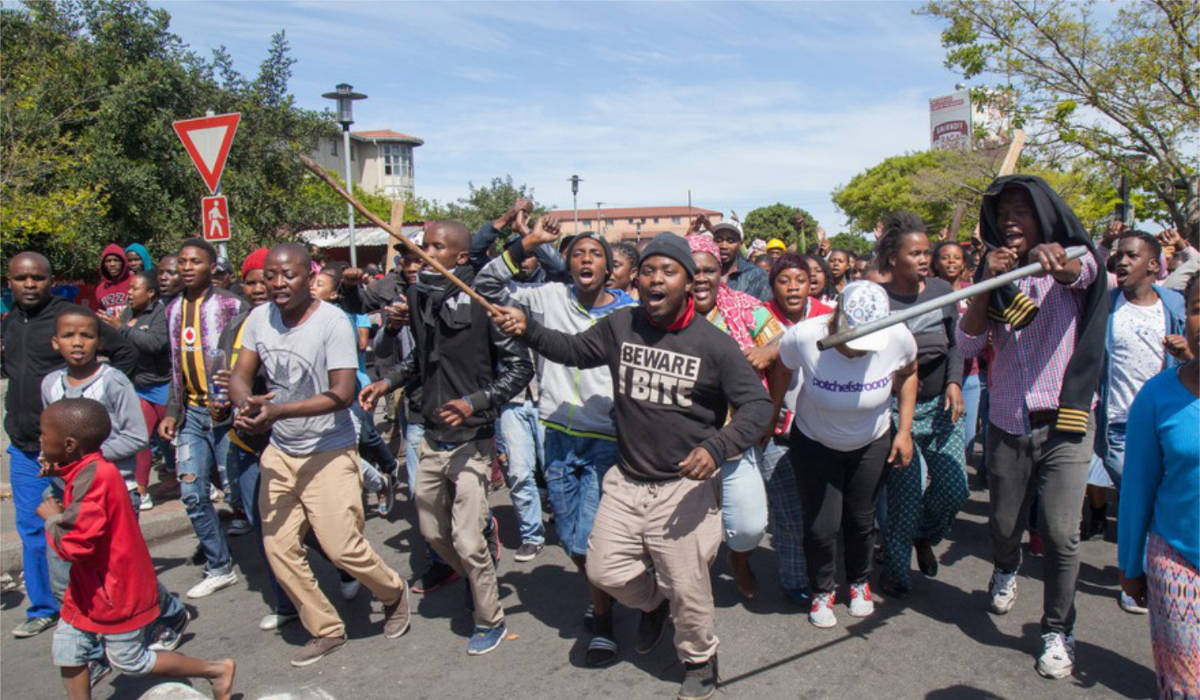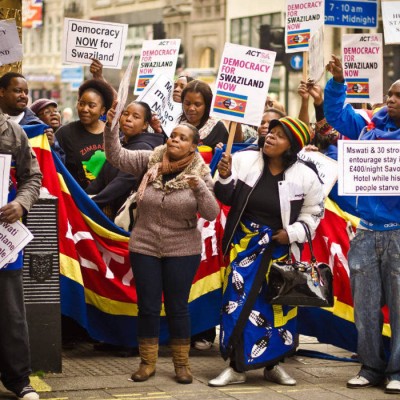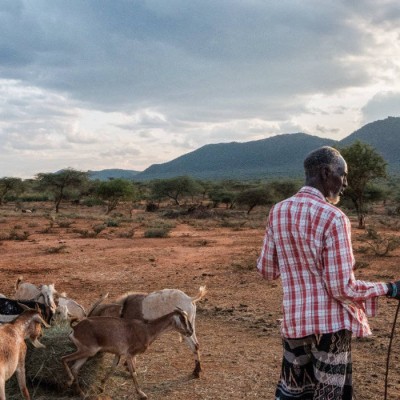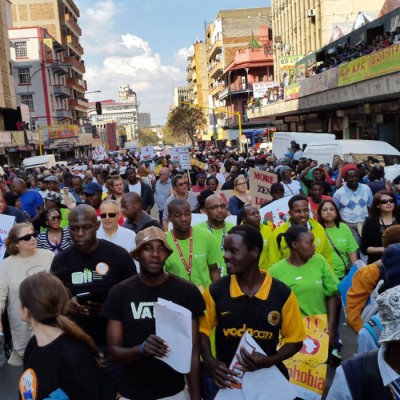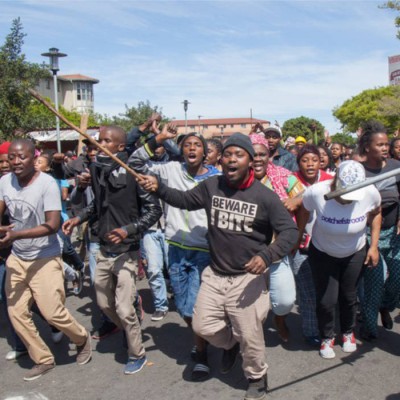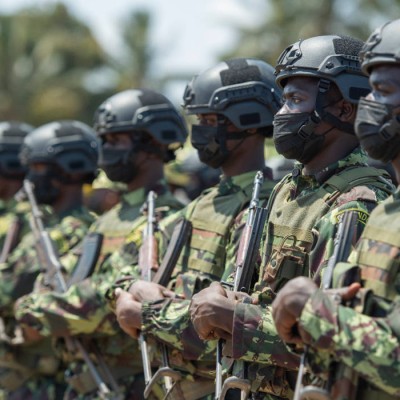Introduction
In the past five years, Africa has experienced increasingly more complex conflicts, requiring multi-dimensional approaches to enhance and consolidate the responses of states, Regional Economic Communities and Mechanisms (RECs/Ms), and the African Union (AU). Peace and security issues often interlock with those of governance, and in many respects, governance issues are the root causes of most threats to peace and security.
One of the peace and security areas that have become increasingly more complex for states to deal with internally is local and national protest. Protests have become more frequent on the African continent.1Kwasi, Stellah (2021) ‘Africa’s rise in protests is about more than macroeconomics’, Institute for Security Studies, 7 October, Available at: <https://issafrica.org/iss-today/africas-rise-in-protests-is-about-more-than-macroeconomics> [Accessed: 9 May 2023]. While there are various causes attributed to the increase in protest action, most of them emanate from governance shortfalls in Africa. Protests are an important avenue for citizens to relay domestic grievances, but they can pose a security threat when these issues go unaddressed for prolonged periods.
Among other things, tools to detect and, therefore, respond timeously to emerging conflicts are necessary for countries to address governance issues to prevent the frequency and intensity of protests. In this regard, the AU has recognised the African Peer Review Mechanism (APRM) as an early warning tool for conflict prevention in the context of its harmony and synergy with the African Peace and Security Architecture (APSA) and the African Governance Architecture (AGA).2AU (2018a) ‘Communique: The 30th Ordinary Session of the Assembly, 28-29 January 2018, Addis Ababa, Ethiopia’, Available at: <https://au.int/sites/default/files/decisions/33908-assembly_decisions_665_-_689_e.pdf> [Accessed: 20 April 2023]. This emphasises the nexus between governance and peace and security. The Peace and Security Council (PSC) further acknowledges the importance of the APRM as an effective mechanism for promoting conflict prevention by contributing to addressing structural root causes of conflicts that relate to governance.3AU Peace and Security Council (2018) ‘Press Statement: Peace and Security Council 819th Meeting, 19 December 2018, Addis Ababa, Ethiopia’, Available at: <https://www.peaceau.org/uploads/psc.819.press.statement.briefing.aprm.19.12.2018.pdf> [Accessed: 20 April 2023].
This article aims to assess the APRM Country Review Reports (CRRs) as early warning tools for identifying, preventing, mitigating, and addressing governance issues that cause, and arise from, domestic protests. Therefore, it looks at three APRM CRRs produced from 2018 to identify early warnings which can be linked to protests. Moreover, it will analyse the extent to which these early warnings were used in the domestic context of the member countries reviewed during this period, with a view to preventing or responding to local and national protests.
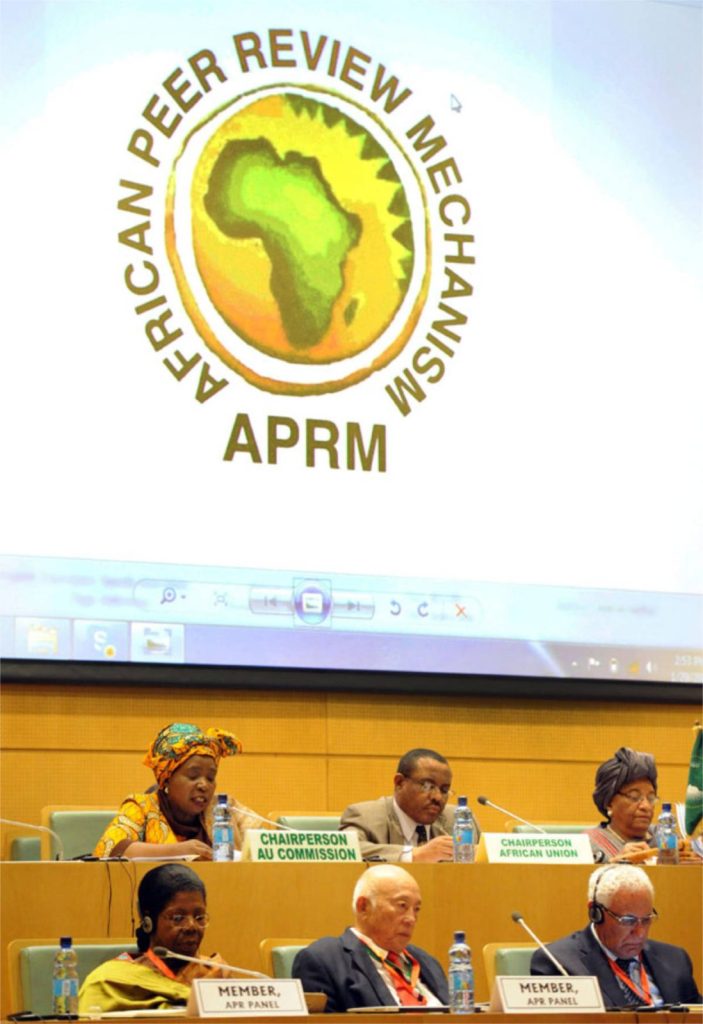
Photo: GCIS
Governance, Peace and Security
The nexus between governance and peace and security is evident within the institutional framework of the AU. The AU has a broad mandate that includes the overall responsibilities of promoting peace and security and good governance in Africa.4AU (n.d. a) ‘About the African Union’, Available at: <https://au.int/en/overview> [Accessed: 20 April 2023]. These responsibilities are fulfilled through the various subsidiary institutions, mainly the APSA, AGA, and APRM.
The APSA contains the key mechanisms of the AU for the promotion of peace, security and stability. The PSC, as the main APSA pillar, is ‘a collective security and early warning arrangement’ that aims to anticipate and prevent disputes and conflicts timeously and effectively.5AU (n.d. b) ‘The Peace & Security Council’, Available at: <https://au.int/en/psc> [Accessed: 20 April 2023]. Importantly, the PSC’s powers (in partnership with the AU Commission) include reviewing the promotion of democratic principles and good governance. Another pillar of the APSA is the Continental Early Warning System (CEWS), with the objective of anticipating and preventing conflicts, and providing timeous information about evolving violent conflicts on the continent. The CEWS consists of the Situation Room, tasked with information monitoring and data collection on simmering, potential and actual conflicts and post-conflict initiatives.6Ibid. Considering the abovementioned functions, one can begin to map out a link between good governance and democracy, and conflict prevention and early warning tools at an institutional level of the AU.
The AGA is premised on the AU’s Constitutive Act that, among other things, aims to ‘consolidate democratic institutions […] and ensure good governance and the rule of law’.7AU (n.d. c) ‘About AGA’, Available at: <https://au.int/en/aga/about> [Accessed: 20 April 2023]. The AGA has the main objective of implementing the AU’s Shared Values, particularly the African Charter on Democracy, Elections and Governance (ACDEG). One of the AGA’s focus areas is the AGA-APSA synergy, which recognises that good democratic governance requires a peaceful context and vice versa.8AU (n.d. d) ‘AGA Areas of Focus’, Available at: <https://au.int/en/aga/what-we-do> [Accessed: 20 April 2023]. This reiterates the importance of harmonising relevant institutional frameworks in advancing the AU’s aspirations for democratic governance and peace on the continent.9AU (2022a) ‘11th High-Level Dialogue on Democracy, Governance and Human Rights and its pre forums on Youth and Gender Cotonou, Benin’, 14–25 November, Available at: <https://au.int/en/newsevents/20221114/11th-high-level-dialogue-democracy-governance-and-human-rights> [Accessed: 20 April 2023].
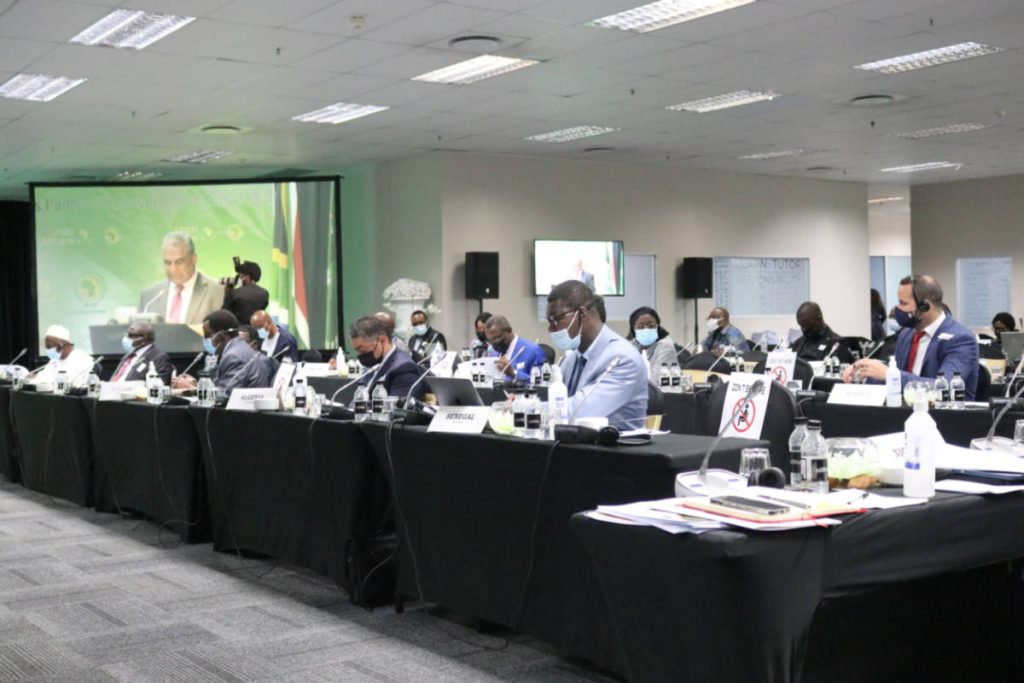
Photo: ACCORD
The APRM as an Early Warning Tool for Conflict Prevention
The APRM commemorates its 20th anniversary this year. It was established by the AU in 2003 as Africa’s self-assessment mechanism for good governance. It is a tool for experience sharing and best practices, identifying deficiencies, and assessing capacity-building needs towards political stability and sustainable socio-economic development.10AU (n.d. e) ‘African Peer Review Mechanism (APRM)’, Available at: <https://au.int/en/organs/aprm> [Accessed: 23 May 2023]. The APRM member countries undertake self-monitoring around aspects of domestic governance and socio-economic development. This creates a platform for national dialogue on governance and socio-economic indicators to build consensus on the way forward.11Ibid. Through the APRM processes, member countries identify key governance issues and receive recommendations from peers that are consolidated into CRRs.
There are four types of CRRs facilitated through the APRM. First, the Base Review is conducted after a country accedes to the APRM. Second, a Periodic Review is conducted every two to four years by all member countries. Third, a (Requested) Targeted Review is requested by a member country to focus on a specific governance issue. Fourth, an Early Warning Review is ‘commissioned by the APR Forum when there are early signs of pending political and economic crises’.12Ibid. The APRM conducts its Reviews based on the four thematic areas of Democracy and Political Governance, Economic Governance and Management, Corporate Governance, and Socio-Economic Development. The work of the APRM addresses Agenda 2063,13South African Institute of International Affairs (2021) ‘The APRM in a Nutshell’, 26 February, Available at: <https://saiia.org.za/wp-content/uploads/2021/02/Dalmar-APRM-Zimbabwe-CSO-Sensitisation-26.02.2021.pdf> [Accessed 21 April 2023]. specifically Aspiration 3 (An Africa of Good Governance, Democracy, Respect for Human Rights, Justice and the Rule of Law) and Aspiration 4 (A Peaceful and Secure Africa). Furthermore, its work is guided by the Declaration on Democracy, Political, Economic and Corporate Governance and the ACDEG. Thus, its mandate complements and overlaps with the AGA and the APSA.
It is against this backdrop that the AU Assembly welcomed steps ‘to position the APRM as an early warning tool for conflict prevention on the continent’ in January 2018.14AU (2018b) ‘Assembly of the Union Thirtieth Ordinary Session 28 – 29 January 2018 Addis Ababa, Ethiopia’, Assembly/AU/Dec.686 (XXX), Available at: <https://au.int/en/newsevents/20180128/assembly-union-thirtieth-ordinary-session-28-%E2%80%93-29-january-2018-addis-ababa> [Accessed 25 April 2023]. This decision was recalled in December 2018 by the PSC, when the importance of the APRM as one of the most effective mechanisms for promoting conflict prevention was acknowledged. This is because ‘it contributes in addressing some of the structural root causes of conflicts’ related to governance.15AU (2018c) ‘The 819th meeting of the AU Peace and Security Council on the review reports of various countries’, Press Statement, 19 December, Addis Ababa, Ethiopia, Available at: <https://www.peaceau.org/en/article/the-819th-meeting-of-the-au-peace-and-security-council-on-the-review-reports-of-various-countries> [Accessed 25 April 2023]. Furthermore, the PSC encouraged close collaboration between the APR Panel and the AU Panel of the Wise on relevant preventive diplomacy efforts.
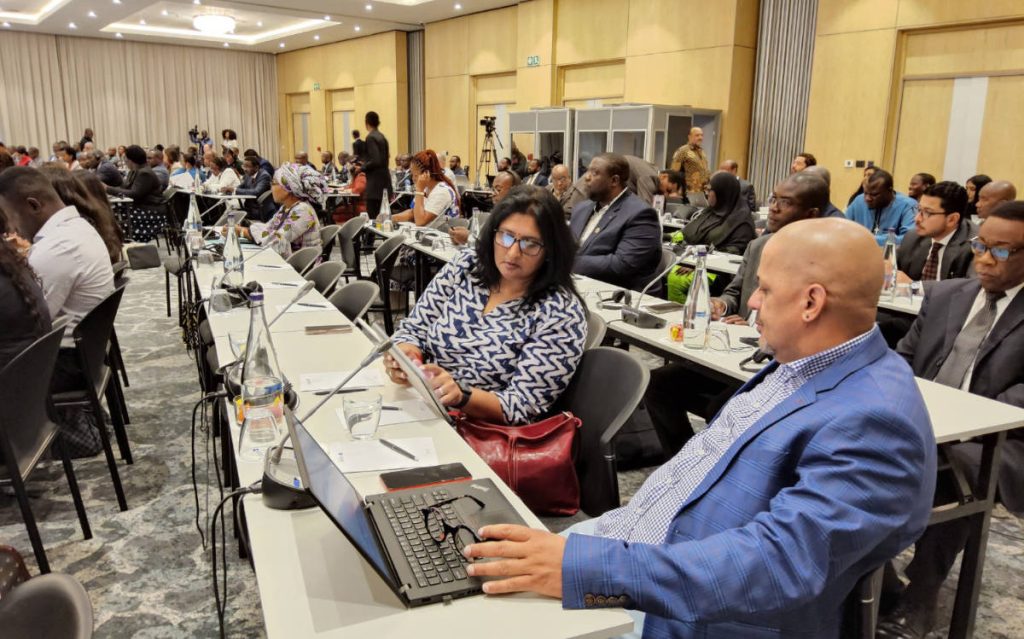
Photo: ACCORD
The PSC has also underscored the need to enhance the coordination and synergy of efforts and requested the convening of an annual Joint Retreat with the APRM16AU (2020a) ‘Communique’ of the Peace and Security Council 914th Meeting, 05 March 2020, Addis Ababa, Ethiopia, on the reports by the African Peer Review Mechanism (APRM) as well as the steps taken to position the APRM as an Early Warning Tool for Conflict Prevention’, Available at: <https://www.peaceau.org/en/article/communique-of-the-914th-meeting-of-the-psc-5-march-2020-on-the-reports-by-the-peer-review-mechanism-apmr-as-well-as-the-steps-taken-to-position-the-aprm-as-an-early-warning-tool-for-conflict-prevention> [Accessed: 25 April 2023]. to exchange views and engage on the various CRRs undertaken to enhance early warning strategies and address root causes of conflicts.17AU (2020b) ‘Communiqué of the 962nd PSC Meeting, 05 November 2020, Addis Ababa, on the briefing by the African Peer Review Mechanism (APMR) on the Country Review Report of the Republic of Mozambique’, Available at: <https://www.peaceau.org/en/article/communique-of-the-962nd-meeting-held-on-5-november-2020-on-the-briefing-by-the-african-peer-review-mechanism-apmr-on-the-country-review-report-of-the-republic-of-mozambique> [Accessed: 25 April 2023]. The First Joint Retreat of the PSC and APRM took place from 19 to 21 December 2021 in Durban, South Africa. In his opening remarks, Tesfaye Yilma Sabo acknowledged the importance of the APRM-PSC Retreat in highlighting the significance of CRRs between 2018 and 2020 in providing lessons that would inform the AU’s preventative diplomacy efforts. He further emphasised the APRM’s role in identifying political issues before they develop into political conflicts.18APRM (2021a) ‘First Joint Retreat of the Africa Union Peace and Security Council (PSC) and the African Peer Review Mechanism (APRM)’, 23 December, Available at: <https://www.aprm-au.org/publications/first-joint-retreat-of-the-africa-union-peace-and-security-council-psc-and-the-african-peer-review-mechanism-aprm> [Accessed: 26 April 2023]. The conclusions of this Joint Retreat were subsequently adopted by the PSC.19AU (2022b) ‘Communiqué: PSC’s 1069th Meeting, 10 March 2022, on the Conclusions of the Inaugural Joint Retreat of the PSC and the APRM (eThekwini Conclusions)’, Available at: <https://papsrepository.africa-union.org/handle/123456789/1508> [Accessed: 1 June 2023]. The PSC went further and decided to institutionalise the annual convening of the Joint Retreat, underscored the need to invite other relevant stakeholders to the Retreats in future (including the Panel of the Wise), and called on the APRM to strengthen its prevention mechanism to enhance its role of anticipating crises and conflicts.20AU (2022c) ‘Communiqué: PSC’s 1069th Meeting, 10 March 2022, on the Conclusions of the Inaugural Joint Retreat of the PSC and the APRM (eThekwini Conclusions)’, Available at: <https://papsrepository.africa-union.org/handle/123456789/1508> [Accessed: 26 April 2023].
The Second Joint Retreat of the PSC and APRM was held on 14 and 15 November 2022 in Durban, South Africa, under the theme: Strengthening the nexus between Governance and Peace and Security on the Continent: Enhancing PSC and APRM cooperation on early warning for conflict prevention, in harmony and in synergy with the APSA and the AGA. The conclusions of the Second Joint Retreat emphasised the need to address the root causes of conflict leading to instability and increased violence, including prolonged economic frustrations, unemployment, corruption and exclusion.21AU (2022d) ‘Conclusions of the Second Joint Retreat of the PSC and APRM, 14 – 15 November 2022, Durban, South Africa’, Available at: <https://papsrepository.africa-union.org/handle/123456789/1789> [Accessed 26 April 2023]. In fact, these issues have been the cause of recent protest action in APRM member countries.
Protests in APRM Member Countries: Egypt, Namibia and Uganda
Protest has always been an integral element of democracy. It is instrumental in enabling citizens to express dissent, opinions, expose injustices, and demand accountability from those in power.22Amnesty International (2022) ‘Protect the Protest: Why we must save our right to protest’, Available at: <https://www.amnesty.org/en/documents/ACT30/5856/2022/en> [Accessed: 26 April 2023]. Importantly, protests can be considered a sign of shortfalls in governance and a mechanism for citizens to escalate longstanding and unaddressed concerns. Statistical analyses have shown an increase in the number of protests and the risk of civil unrest in Africa over the past six years.23Kedem, Shoshana (2023) ‘Civil unrest in Africa soars to six-year high’, African Business, 25 May, Available at: <https://african.business/2023/05/politics/civil-unrest-in-africa-soars-to-six-year-high> [Accessed: 2 June 2023]. In some cases, incidents of violence during protests have intensified, raising peace and security concerns. This suggests that protests can threaten domestic political stability if not mitigated sufficiently.
The APRM has a role in promoting good governance and addressing the root causes of conflict leading to instability. The information produced in the APRM’s CRRs is useful for member countries to prevent and mitigate potential and ongoing conflict situations. This includes tensions arising from domestic protests. Three of the member countries that conducted APRM CRRs from 2018 experienced significant protests related to domestic governance and socio-economic grievances. These countries are Egypt, Namibia and Uganda. What follows is a brief case study analysis of each of the three CRRs to identify the governance, peace and security challenges before domestic protests occurred. The recommendations provided in these CRRs will be analysed to assess the extent to which the early warnings were acted upon, possibly to prevent or mitigate issues arising from subsequent domestic protests.
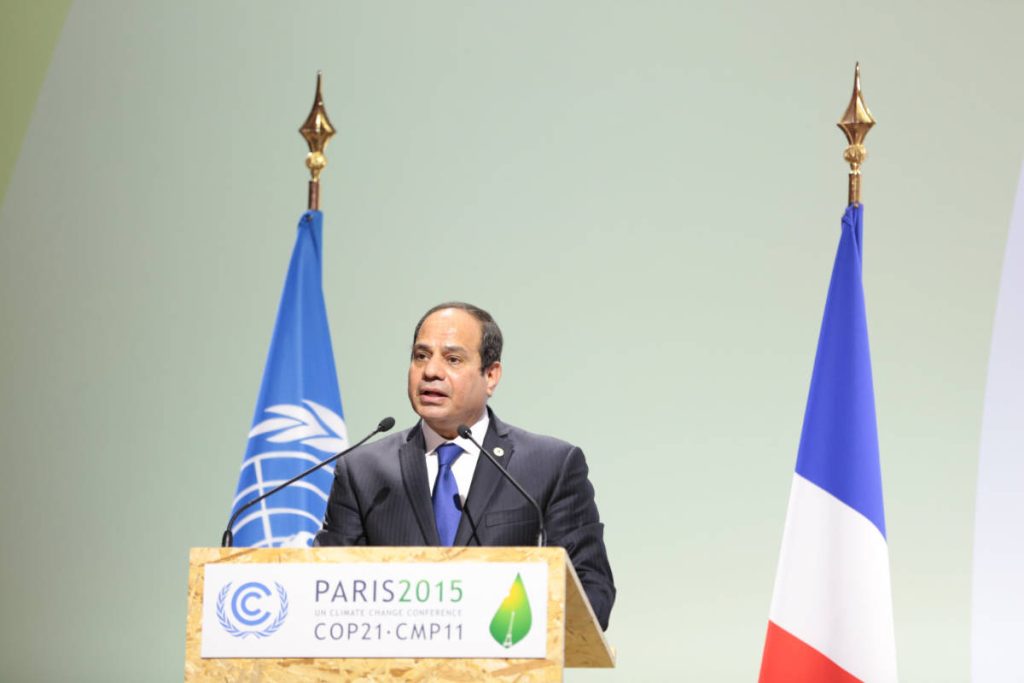
Photo: UNclimatechange
In 2019, Egypt experienced mass protests between 20 and 27 September. This was after Mohamed Ali, a self-exiled Egyptian businessperson and actor, called for protests against President El-Sisi’s regime because of alleged corruption.24Al Jazeera (2019) ‘In rare protests, Egyptians demand President el-Sisi’s removal’, 21 September, Available at: <https://www.aljazeera.com/news/2019/9/21/in-rare-protests-egyptians-demand-president-el-sisis-removal> [Accessed: 26 April 2023]. Thousands of people took to the streets in Cairo, Alexandria, Damietta, Suez, Kafr El Sheikh and four other cities. These protests called for the resignation of President El-Sisi, due to alleged corruption and repression,25Michaelson, Ruth (2019) ‘Hundreds of Egyptians arrested in latest wave of protests against Sisi’, The Guardian, 22 September, Available at: <https://www.theguardian.com/world/2019/sep/22/hundreds-of-egyptians-arrested-in-latest-wave-of-protests-against-sisi> [Accessed 10 May 2023]. and for democracy and human rights. The government responded by deploying police who fired teargas, rubber bullets and live rounds, and arrested over 2 285 people.26Yee, Vivian and Rashwan, Nada (2019) ‘Egypt’s Harsh Crackdown Quashes Protest Movement’, New York Times, 4 October, Available at: <https://www.nytimes.com/2019/10/04/world/middleeast/egypt-protest-sisi-arrests.html> [Accessed: 10 May 2023].
Having acceded to the APRM in 2004, Egypt published their APRM CRR in February 2020.27APRM (2020) ‘The Country Review Report of the Arab Republic of Egypt’, February, Available at: <https://www.aprm-au.org/publications/egypt-country-review-report> [Accessed: 3 May 2023]. What is interesting is that the issues that sparked the 2019 protests – corruption and democratic and human rights – formed part of the core findings and recommendations of the APR Panel. In fact, the CRR identified corruption and the promotion of human rights as key crosscutting and overarching governance issues.28Ibid, p. 430 and 423. One of the main recommendations made by the APRM Panel on issues concerning Egypt’s Democracy and Political Governance was to consider signing the ACDEG.29 Ibid, p. 95. This is to provide a framework for the country’s democratic governance and consolidation, which has been a source of protest action. The ACDEG is also vital as it forms the core of the AGA’s work. To date, there is no record of Egypt signing the ACDEG.
Concerning the protection of human rights, the APRM Panel recommended the strengthening of ‘protections for free operations of civil society groups’.30 Ibid, p. 119. However, reports by Human Rights Watch suggested that hundreds of anti-government civil society protestors and activists were detained between 1 October and 14 November 2022.31Human Rights Watch (2022) ‘Egypt: Detentions, Repression Follow Protest Calls’, 16 November, Available at: <https://www.hrw.org/news/2022/11/16/egypt-detentions-repression-follow-protest-calls> [Accessed 18 May 2023]. While the APRM Panel’s efforts accurately identified issues that could lead to protests and potential civil unrest, and the recommendations provided seem to be acknowledged, there has been little implementation by the member country in question.
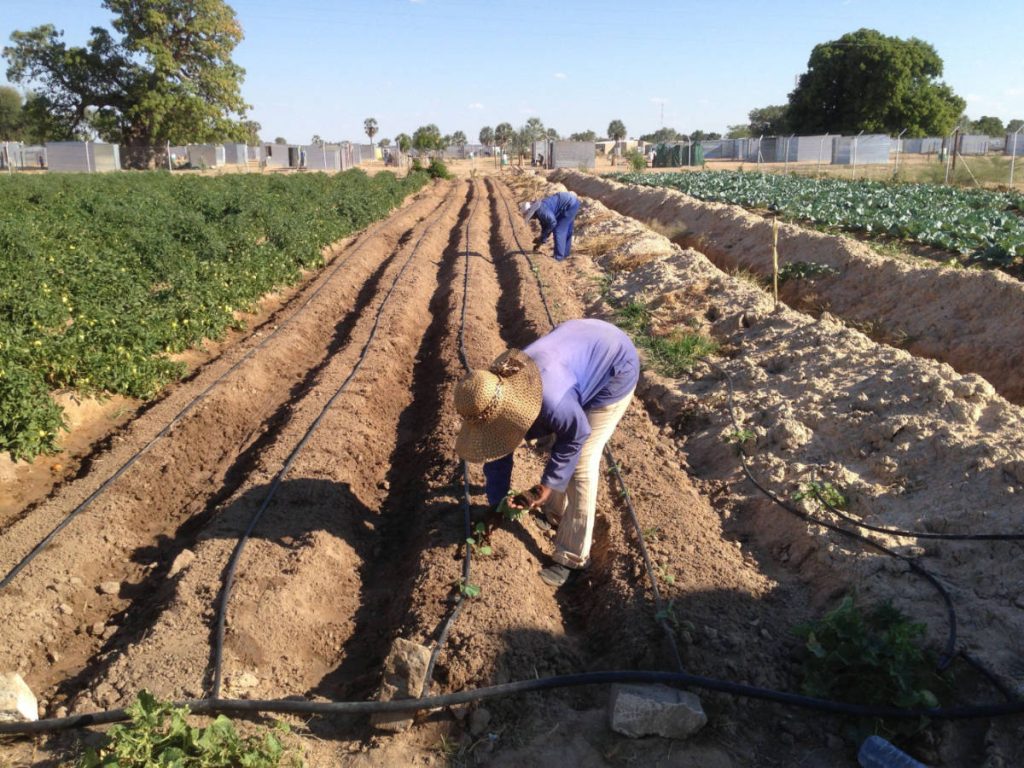
Photo: UNclimatechange
Namibia produced an APRM Targeted Review Report on Youth Unemployment in the Republic of Namibia, published in November 2021. A Targeted Review is conducted upon request by a member country on a specific issue. The Namibian government identified the issue of youth unemployment as a key area of assessment in relation to promoting good governance. This case presents an illustration of how the APRM’s processes can be used by member countries to identify pertinent governance issues that urgently need addressing. It is through this process that member countries are able to obtain recommendations on how best to address the challenges it faces. The issue of youth unemployment is a high risk to political stability within any state. This is especially the case in Africa, where many young people are not in employment, education or training.32International Labour Organization (2020) ‘Global Employment Trends for Youth 2020: Africa’, Available at: <https://www.ilo.org/wcmsp5/groups/public/—dgreports/—dcomm/documents/briefingnote/wcms_737670.pdf> [Accessed: 18 May 2023]. While Namibia has not recorded internal overt conflict, there are frustrations around the high level of youth unemployment,33APRM (2021b) ‘Targeted Review Report on Youth Unemployment for the Republic of Namibia (Key Highlights)’, Report No. 4, November, <https://www.aprm-au.org/publications/targeted-review-on-youth-unemployment-in-namibia> [Accessed: 15 May 2023], p. 12. which was estimated to be 40.15% in 2021.34O’Neill, Aaron (2023) ‘Youth unemployment rate in Namibia in 2022’, 12 May, Statista, Available at: <https://www.statista.com/statistics/812268/youth-unemployment-rate-in-namibia> [Accessed 18 May 2023]. One of the recommendations by the APR Panel was for the Namibian Government to ‘address youth unemployment as a major priority through increasing investment in agriculture and tourism’.35APRM (2021b), op cit., p. 30. The APR Panel further recommended the strengthening of policies that facilitate credit access and microfinancing for young people in order to combat poverty and unemployment.
On 21 March 2023, which is Namibia Independence Day, a protest was planned to spotlight youth unemployment.36Namibia Fact Check (2023) ‘EXPLAINER: The right to protest in Namibia’, 21 March, Available at: <https://namibiafactcheck.org.na/news-item/explainer-the-right-to-protest-in-namibia> [Accessed: 16 May 2023]. The government used the court to interdict the protest on the grounds of national security and directed a rescheduling of the protest after Independence Day.37Ibid. Despite this, protests continued in Ohangwena, Walvis Bay, Keetmanshoop, and Windhoek. Multiple activists and young people were arrested, with accusations of police brutality and violations of the Constitutional right to protest.38Tendane, Sophie; Hartman, Adam; and Alberts, Ellen (2023) ‘Police unleash force on unemployed youth’, The Namibian, 23 March, Available at: <https://www.namibian.com.na/police-unleash-force-on-unemployed-youth> [Accessed: 16 May 2023]. In light of these protests, the work of the APRM arguably succeeded as an early warning tool, as it identified youth unemployment as a point of conflict. The availability of Targeted Reviews provided the Namibian government with a useful mechanism and opportunity to address one of the country’s pertinent challenges.
However, Namibia’s youth unemployment rate remains high, at close to 40% in 2022,39O’Neill, Aaron (2023) op cit. and the pace of implementation would seem slow. Namibia has since commissioned a National Task Force on the implementation of the Targeted Review Report. It was officially established in February 2023 by the Ministry of Sport, Youth and National Service. The purpose of the National Task Force is to spearhead the implementation of the APRM’s recommendations and the compilation of the progress report according to its National Action Plan.40Ministry of Sport, Youth and National Service, Namibia (2023) ‘Remarks by Honourable Emma Kantema-Gaomas, Deputy Minister, Ministry of Sport, Youth and National Service at the Inaugural Meeting of the National Task Force on the Implementation of the Targeted Review Report on Youth Unemployment in the Republic of Namibia’, 3 February, Available at: <https://www.msyns.gov.na/documents/370787/1704283/Remarks+by+Hon+Emma+Kantema+-+Gaomas%2C+Deputy+Minister%2C+at+the+Inaugural+meeting+of+the+National+Task+force+on+the+implementation+of+the+Targeted+Review+Report+on+Youth+Employment+in+the+Republic+of+Namibia.pdf/90021bc8-95f6-8ffb-ce6c-ba5d9ed86bdd?t=1675420801390> [Accessed 18 May 2023]. This action indicates a crucial step towards accelerating the implementation of the APRM’s recommendations found in the report by exploring avenues within Namibia’s existing policy frameworks.
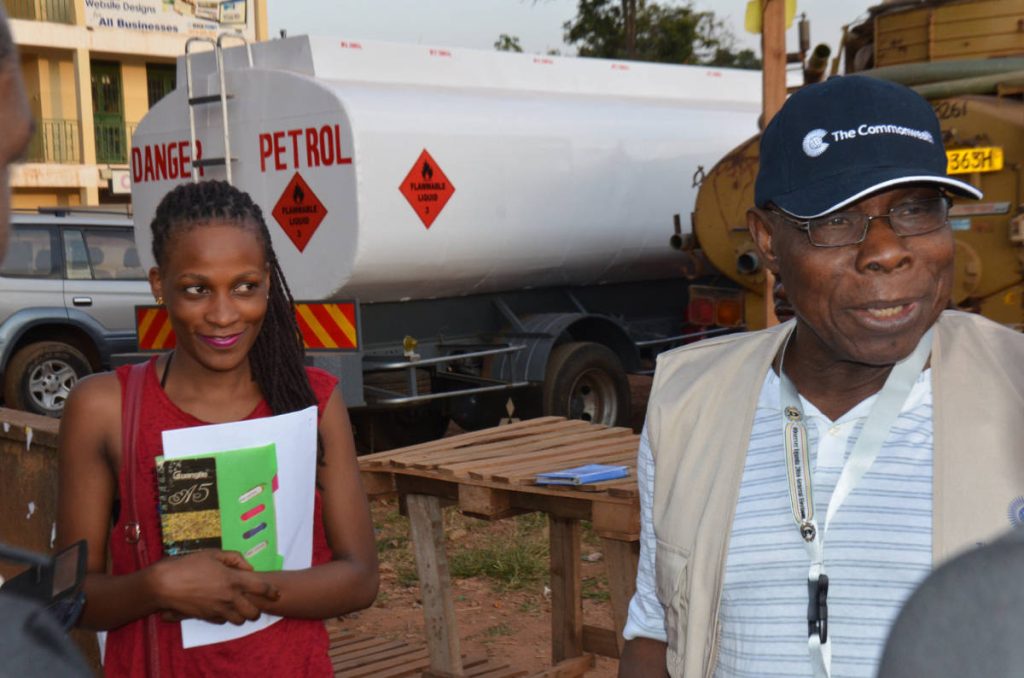
Photo: The Commonwealth
InUganda, there were various protests in the years leading up to itsAPRM CRR of January 2018. Many of the protests that received extensive media coverage fall within the Democracy and Political Governance thematic area of the APRM. Reports documented violent clashes between police and opposition supporters in Uganda’s capital of Kampala during the 2016 election period. This was after the detention of presidential candidate Kizza Besigye.41Marima, Tendai (2016) ‘Violence erupts days ahead of Uganda elections’, Al Jazeera, 16 February, Available at: <https://www.aljazeera.com/news/2016/2/16/violence-erupts-days-ahead-of-uganda-elections> [Accessed: 15 May 2023]. In 2017, there was widespread public discontent over a law that sought to remove presidential age limits, which culminated in dozens of protests in the country.42Mugabi, Isaac (2017) ‘Dozens of protestors arrested in Uganda’, Deutsche Welle, 1 July, Available at: <https://www.dw.com/en/ugandan-police-arrests-dozens-over-presidential-age-limit-protest/a-39767048> [Accessed: 16 May 2023]. Many protesters were arrested, including opposition leader Norbert Mao.
Uganda’s Second APRM CRR of January 2018 documents four important challenges under the Democracy and Political Governance thematic area. One of them is the fair competition for political power relating to levelling the playing field between different political parties. Another relates to the dominance of the Executive arm of government and weak checks and balances.43APRM (2018) ‘Republic of Uganda Key Highlights of the Second Country Review Report for Discussions at the 27th Summit of the APR Forum’, January, p. 1. An interesting detail of Uganda’s CRR is that the debate on removing the constitutional election age limit was not mentioned in Uganda’s Country Self-Assessment Review report in 2017. However, after the Country Review Mission, the APR Panel identified this as ‘the most explosive issue in the country at the time’.44Ibid, p. 2. Succeeding the publication of the APRM CRR, Uganda continued to witness protest action pertaining to the very same issues of democracy and political governance. In 2020, the country witnessed deadly protests after two presidential candidates were arrested during their campaigns ahead of the January elections.45Dahir, Abdi Latif (2022) ‘Deadly Protests Erupt in Uganda After Arrest of 2 Opposition Figures’, New York Times, 19 November, Available at: <https://www.nytimes.com/2020/11/19/world/africa/uganda-bobi-wine-arrest.html> [Accessed: 17 May 2023]. At least 300 people were reportedly arrested after protesting in major cities, such as Jinja, Masaka, and Kampala. The report correctly identified issues that would later lead to protests in Uganda. Therefore, this suggests a lack of adequate political will to implement the recommendations of the APRM’s CRRs.
Conclusion
The APRM CRRs offer insights into the overall state of governance in member countries. As evidenced by the county case studies, the governance issues identified within the process of formulating CRRs can cause protests to erupt. The recommendations provided by the APR Panel have the potential to assist countries under review with addressing the root causes of intrastate tensions manifesting in protest action. However, as in the case of Egypt and Uganda, these recommendations require the necessary political will. The efficient implementation of the recommendations can help improve governance and divert potential civil unrest. More may need to be done to encourage consistency concerning the submission of Annual Progress Reports by member countries to constantly follow up on the progress in implementation of the National Programmes of Action.
In other instances, such as in Namibia, the Targeted Review Reports provide member countries with an opportunity to seek assistance in governance areas that are potential threats to political stability. Member countries experiencing increased numbers and intensity of protests need to make use of the Targeted Review mechanism to look into governance issues raised by these protests. Moreover, the APR Forum should consider commissioning more Early Warning Reviews in African countries experiencing frequent and intense domestic protests, as these can be early warning signs of governance issues that may threaten political stability. This will enhance the capability of the APRM as an early warning tool for conflict prevention and further consolidate the APSA-AGA-APRM synergy.
Nkanyiso Simelane is a researcher at ACCORD.

